Financial crisis could pave way for greener economy inspired by nature
mongabay.com
October 20, 2008
Biomimicry — the use of nature to inspire design — could serve as a model for a greener economy that rises out of the ashes of the financial crisis, said experts meeting at a sustainability conference in the San Francisco Bay Area.
Speaking at the three-day Bioneers conference in San Rafael, Janine Benyus, a leading voice in the emerging field of biomimicry, said that nature offers lessons that can be applied to build better and more sustainable products and services as well as economic models.
“At the same time that we were meeting there was this economic quake going on,” she said, referring to her attendance of the IUCN meeting in Barcelona two weeks ago. “All these crystal gobblets going off the table and crashing. We’d wake up in the morning and come from our hotel room and there would be all these newspapers from all over the world and they all had the same pictures… of people with their heads in the hands like a Godzilla film going ‘ahhhh’. That’s the sound of the old paradigm falling.”
Noting that many companies and entrepreneurs are using nature’s models “to redesign everything”, Benyus said she hoped the economy could become more like the food web of an old-growth forest where “nothing is lost.”
“That’s the way our economy needs to work,” she explained. “One company’s discards being hungrily gobbled by the next company — sharing resources in a food web that considers everything precious.”
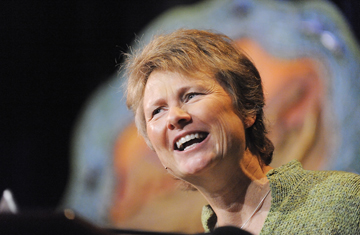 Janine Benyus speaking at the Bioneers conference |
“When you look at the water coming out of a very mature forest, there’s hardly anything in it in terms of nutrients,” she continued. “[These have] been pulled up by this forest and used over and over again. That’s where we have to be as well.”
Jay Harman, President and CEO of PAX Scientific, a company that develops highly efficient industrial equipment based on patterns found in nature, added that the current economic crisis offers “an incredible opportunity” for developing a more sustainable economy.
“Everything is melting down [but this] is an incredible opportunity for a new economy… There are an awful a lot of new ideas for the new economy that haven’t been put on the table yet,” he said during a panel discussion entitled “Nature’s Best: Biomimicry’s Climate-Change Solutions” with Benyus; Stephen Dewar of WhalePower, a company developing wind and hydro turbines, pumps, and fans based on the design of whale flippers; and Charles Hamilton, president of Novomer, a firm producing biodegradable plastics using carbon dioxide as a feedstock. “There is a historic tide of new thinking and new business models.”
“Nature has already solved almost every problem,” he continued. “Nature is clean, green, and sustainable… Biomimciry is still a very fresh movement.”
“This is a huge opportunity to see the biomemetic design in the flesh,” added Benyus.
“Open secrets of nature”
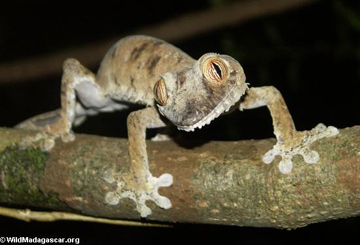 The leaf-tailed gecko (Uroplatus fimbriatus) is found on the island of Madagascar. Gecko’s feet are being used as a model to design a a biodegradable surgical adhesive that dissolves harmlessly after an injury heals. |
While designers have long been inspired by nature, the idea that the world around us can be used as a 3.8-billion-year-old R&D lab for technology development is gaining momentum. Benyus, author of Biomimicry: Innovation Inspired by Nature and founder of the nonprofit Biomimicry Institute, reviewed dozens of examples she and her colleagues have come across while reviewing scientific literature.
“We went through the biological literature. We had a list of life’s greatest sustainability challenges on our left hand and on our right we had scientific papers and we filtered through,” she said. “When we finally had to stop we had over 2100 phenomenal ideas. Things that have been mimicked, things that should be mimicked and have not yet been.”
Benyus organized the ideas by function and found that nature has come up with many approaches to solving difficult challenges that presently confront humankind, including 49 new ways to generate energy, 23 new ways to absorb water and 44 ways to store it, 58 new ways to manage extreme temperatures, 42 news ways to cooperate, and more than 180 ways to communicate.
“Do we need 146 ways to do water-based chemistry?” she asked. “You bet. We [currently] use toxic solvents.”
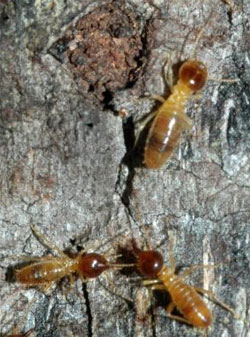 The stomach microbes of termites are being studies for the development of more sustainable and higher yielding biofuels. Credit: David Gilbert, DOE Joint Genome Institute |
She cited many examples of companies using nature’s best ideas to develop products and services including Aquaporin, a Danish outfit developing cell membrane-inspired water purification technology; Biosignal, an Australian firm that has developed a red algae-inspired bacteria shield that doesn’t breed antibiotic resistance; Cambridge Biostability, a company developing a plant-inspired technology that enables vaccines to be stored without the need for refrigeration; PureBond, a mussel-inspired wood adhesive from Colombia Forest Products; BioPower Systems, a company working on a kelp-inspired wave energy harvester; Speedo’s LZR Racer suit, worn by gold medal winner Michael Phelps, and modeled after shark skin; leaf-inspired solar cells from Dyesol and Konarka; Calera, a firm which uses carbon dioxide as a feedstock for concrete much like corals; as well as WhalePower, Novomer, and Pax Scientific. She said nature offers models to sequester carbon while increasing the fertility of soils and water; travel without harmful emissions or congestion; produce food and fuel without pesticides or diminishing biodiversity; and harvest water in ways never before imagined.
Benyus said that biomimicry does more than just inspire design, it creates powerful new incentives for conserving biodiversity.
“For me this is a new way of viewing and valuing biodiversity,” she said, adding that a new initiative (innovationforconservation.org) will encourage firms that use nature as a model for design to donate a portion of their proceeds to conservation of the species and habitats which inspired their work.
Her Biomimicry Institute is also developing a resource to facilitate easier use of nature’s models: AskNature, a web site with biological information organized by function. The site will be integrated with Harvard biologist E.O. Wilson’s ambitious Encyclopedia of Life, a site that aims to create a web page for every one of Earth’s species.
Bioneers
Related articles
 |
Continued focus on economic growth will doom the planet say ecologists
(10/15/2008) An economy that focuses on economic growth above all else will lead to "disaster", argues a series of editorials published in this week's issue of New Scientist magazine. Citing the current financial crisis, where governments have signaled their fear of anything that threatens growth by pouring hundreds of billions of dollars into failing banks and financial institutions, a group of economists question the logic of an economic system built on the assumption of growth based on continued exploitation of Earth's finite resources.
The green movement has to become a rainbow-colored movement in order to be successful
(6/23/2008) Van Jones, a social and environmental activist, believes a greener economy not only could save the planet, but also must provide pathways out of poverty for America’s disadvantaged communities. A civil rights lawyer from Yale University, Jones started promoting the idea of “green-collar jobs” in 2005 through the Ella Baker Center for Human Rights in Oakland, California. In September 2007, he launched the “Green for All” campaign. Jones recently took time to share his perspectives with Mongabay.com.
Future cities will be more like ecosystems that enrich society and the environment
(5/28/2008) As The World Science Festival continues in New York this week, specialists in vastly diverse fields across scientific disciplines are coming together to talk about ideas, problems and solutions. From Astronomy to Bioacoustics, the dialogues about challenges and opportunities are rich and inspiring. At the front of this year’s festival rests the issue of sustainability and how scientists, specialists and society will address the imminent environmental and economic trials we are sure to face in a rapidly changing and uncertain world.
Biomimetics, technology that mimcs nature
(7/11/2005) Engineers, scientists, and business people alike are increasingly turning toward nature for design inspiration. The field of biomimetics, the application of methods and systems found in nature to engineering and technology, has spawned a number of innovations far superior to anything the human mind alone could have devised. The reason is simple. Nature, through billions of years of trial and error, has produced effective solutions to innumerable complicated real-world problems. The rigorous competition of natural selection means waste and efficiency is not tolerated in natural systems, unlike many of the technologies devised by humans.
Biomimicry of native prairie yields more bioenergy than corn ethanol
(12/7/2006) Diverse mixtures of plants that mimic the native prairie ecosystem are a better source of biofuels than corn grain ethanol or soybean biodiesel according to a new paper published in the Dec. 8 issue of the journal Science. Led by David Tilman, a biology professor at the University of Minnesota, the research shows that “mixtures of native perennial grasses and other flowering plants provide more usable energy per acre than corn grain ethanol or soybean biodiesel and are far better for the environment,” according to a release from the University of Minnesota.
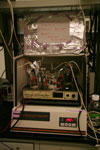 |
Bacteria can generate renewable energy from pollution, help fight global warming
(10/26/2006) Currently, most energy production generates carbon dioxide, a potent greenhouse gas that contributes to global warming and local pollution. At the same time that carbon dioxide concentrations are rising in the atmosphere, fueling higher temperatures, burgeoning population growth of humans and livestock is producing ever-increasing amounts of organic pollution and waste. Now researchers at the Center for Biotechnology at the Biodesign Institute of Arizona State University are working on a way to solve both problems using bacteria to convert organic wastes into a source of electricity. Bruce Rittmann, Director of the Center for Environmental Biotechnology at the Biodesign Institute, and his team of researchers are developing microbial fuel cells (MFC) that can oxidize organic pollutants and create electricity from pollution.
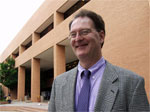 |
Bacteria can ensure clean water say researchers
(10/24/2006) Water is shaping up to be one of the most critical problems facing humanity. With water consumption far outstripping population growth rates due to surging industrial and agricultural demand, the World Bank estimates that 40 percent of the world’s population — more than 2.5 billion people — are enduring some form of water scarcity. In China, where massive river relocation projects to shift water from the south to the dry north are under consideration, an official government survey found that some 300 million Chinese drink unsafe water tainted by chemicals and other contaminants, while 90% of China’s cities have polluted ground water. Elsewhere, development experts say that access to reliable, safe and affordable water is key to poverty alleviation efforts and that addressing declining groundwater supplies and water pollution is be critical to raising the quality of life in poor regions.